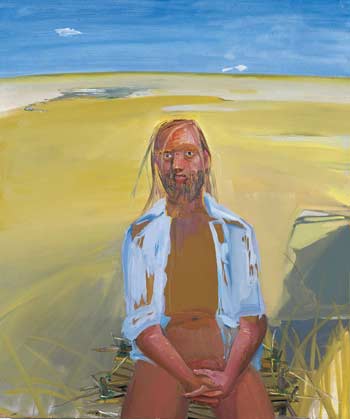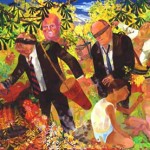“In the end it comes down to what it always comes down to: vision and visionaries. All we have to do is bring it on and not be boring.” -Jerry Saltz
----
Finding fresh criticism for Dana Schutz is not the easiest of tasks. Only three years out of Columbia’s grad program, Schutz has become the biggest star of recent years and seems well on her way to assuming the role of “most celebrated artist” of her generation. Of course, the speed of the art world these days has generations lasting about 5 years, not lifetimes, so to celebrate already seems a tad bit anxious.
With collectors waiting in line and needing to guarantee donation to a museum before purchasing, Schutz has created as much buzz on the speculation of her meteoric rise as with her brash, garish and sometimes good paintings. Indeed, as I strolled through the Rose on a Sunday afternoon I eavesdropped on two separate groups of socialites who were scouting the title cards lamenting, scorning and praising the collectors without even mentioning the titles of the works.
It seems Jerry Saltz is absolutely correct in saying that the Market is the dialog as opposed to the work when considering many of today’s young painters. Any kind of separation between her content and the blood lust around her is near impossible. Curator Raphaela Platow and countless writers have stated that much of her work can be seen as an allegory for painting itself, a category which has been declared dead countless times, yet continues to have major exhibitions just to check its pulse. However, while the paintings may lend themselves to historical recycling (fauvism, german expressionism, neo-expressionism) an allegory to the art world and the economic mechanism’s of capitalist society is far more interesting, and perhaps, more accurate of her practice.
The Rose exhibition is a selection of an evolving narrative that can be roughly grouped into three bodies of work. The earliest series: Frank From Observation, involves Frank who is the “last man on earth”, and herself. Since they are the only two people left and Frank doesn’t paint, it makes her the last painter, an egomaniacal, yet ambitious subject. One of the largest concerns of any business is the motivation to keep competition to a minimum. Being the “last painter” is, in some ways, the ideal economic position. It is much easier to be the best in one’s respective field when you are the only one. Of course, Frank would be her only patron and critic, yet the reality of that position is not what matters. That it corresponds to a kind of desire that is somehow true in the “real” economic world, as opposed to the represented one on canvas is what is useful here.
Frank eventually finds himself as a dismembered still life as seen from Night in Day. From his spare parts, The Breeders were born- a pair of musicians that also launched the “Self-eaters.” This “breed” of life has the uncanny ability to eat themselves, only to digest and regenerate their own limbs. This recycling has often been the main evidence of an allegory to painting: Painting often is self-aware and as much as it decomposes, or deconstructs it manages to continually reinvent itself. However, it is also the self-eaters that most clearly demonstrate the capitalist process.
The Austrian economist Joseph Schumpeter once declared that the re-building or the “incessant revolutionizing from within” is an “essential fact” about capitalism. “Creative Destruction” is a term describing a regenerative process where old powers, industries, processes, crafts, etc. are destroyed in order to incessantly create new ones. In the “self-eaters” we see a perfect allegory to this desperate need. Schutz comments that the self-eaters are “defined by their own production… and are always in a state of becoming”, much like the capitalist process itself. Hurricane Katrina, Iraq, Martha Stewart and 911 are just a few examples where the speculation on the eventual re-building of these destroyed entities outweighs the actual event. In many of the paintings, the breed show very creative acts and artistic talents, literally building from their own destroyed bodies. In other works, presumably more sophisticated planning is taking place amindst a chaotic background- as in Civil Planning.
And then “politics enter the picture.” While an allegory to the economic structures that govern our lives couldn’t be more political, Schutz then turned to specific agents in the process. Men’s Retreat shows Bill Gates, Dennis Kozlowski, and their peers acting like those annoying guys who get naked in the woods and finger paint, hike, and, like, bond and stuff. Humorous as it might sound, this work along with Party, which depicts George Bush’s cabinet wrapped in microphones, make this body of work fall apart. To illustrate the Republican elite cabinet members as lumped together and in disarray is easy and not particularly rewarding. Even more annoying is the implication that inserting these figure-heads is the real venture into politics. While most of her work is based on gimmicks, sometimes to productive ends, this goes too far.
In an interview with curator Raphaela Platow, Schutz doesn't seem inclined to specify what the work is really about, instead opting for universal truisms, like “the creative process.” Even as an economic allegory the work does what all allegories do, which is illustrate rather than mediate. It would be fantastic if Schutz did not have any of the economic allusions in mind, showing how ideological and ubiquitous the market reality truly is, which seems to be the case. With this in mind, a friend remarked to me that Schutz is already out of favor! It seems the market forces always have their way as the next “hot” graduate is already waiting in the wings to replace Schutz’s position. This isn’t exactly cynical, just market logic: Schutz will be destroyed in order to create the next.
Links:
Rose Art Museum, Brandeis University
"Dana Schutz: Paintings 2002-2005" is on view January 19 - April 9, 2006 at insert The Rose Art Museum at Brandeis University.
All images are courtesy of the artist, Zach Feuer Gallery and Saatchi Gallery.







